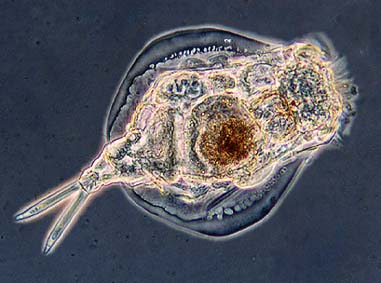Parthenogenesis, or when reproduction no longer requires the intervention of a male
Cultivation of large quantities of zooplankton by parthenogenesis
Today, we are talking about an organism that is barely visible to the naked eye, which increases the survival rates of fish bred in captivity: the rotifer.
Presentation of the rotifer (Brachionus plicatilis)
The rotifer (Brachionus plicatilis) is a zooplanktonic species living in salt and brackish water, tolerating a wide range of salinities. Its adult size does not exceed 300 µm, making it an ideal organism used as feed for fish larvae. Living zooplankton are part of the natural prey of fry. The rotifer, because of its ease of culture, its nutritional profile adapted to many species and its optimal size, is widely used in aquaculture for the reproduction of different species.
This species has been popularised due to its very simple culture conditions. When artemia show significant differences in quality from one batch to another or when copepods require large production capacities to have sufficient quantities, rotifers require little maintenance effort and low costs to feed these larvae over time.
The advantages of rotifer culture in aquarist area
The rotifer has various advantages to be used as a fry feed source.
Indeed, this organism is capable of swallowing 10 times its weight per hour. Therefore, by providing it with a rich food with high nutritional value such as microalgae concentrates, rotifer becomes an excellent intermediary, bringing quality feed to the fry, while stimulating their predation.
Moreover, like certain reptile species (e.g. gecko), rotifers have two distinct modes of reproduction. Sexual reproduction, involving a male and a female, and parthenogenesis (asexual), involving only one female.
Reproduction by parthenogenesis allows the development of an individual from an unfertilized egg, independent of any sexuality. This method of reproduction is practiced when the living environment is ideal, allowing rotifers to develop exponentially in a very short time. Female rotifers will give birth to female offspring only.
Sexual reproduction occurs when the environment is poor or when living conditions become difficult. The females will then produce male eggs, and when the latter reproduce, the females will produce much more resistant eggs, capable of surviving in extreme conditions.
The parthenogenesis method of reproduction allows growers to obtain a large quantity of rotifers in record time, as each female will give birth to females which in turn will produce female eggs and so on (provided that the culture medium is optimal).
Growing Rotifers is therefore a largely viable solution both for feeding fry and also for maintaining the microfauna of the aquarium. You can also use them to feed your corals and invertebrates from time to time who will not be unhappy to have a variety of food. For aquarists who are curious to experiment with new things, growing rotifers can be a start, especially since it is accessible to experts and beginners alike, so no more excuses.

